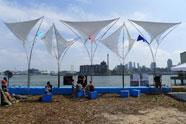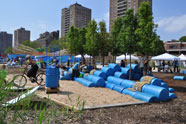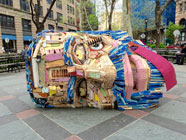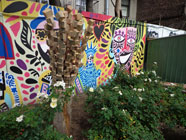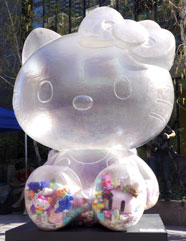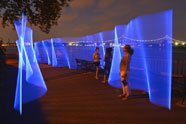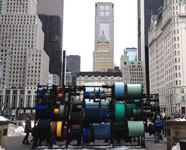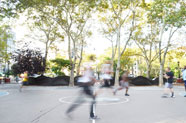Art in the Parks
Through collaborations with a diverse group of arts organizations and artists, Parks brings to the public both experimental and traditional art in many park locations. Please browse our list of current exhibits and our archives of past exhibits below. You can also see past grant opportunities or read more about the Art in the Parks Program.
Public Art Map and Guide
Find out which current exhibits are on display near you, and browse our permanent monument collection.
Search Current and Past Exhibits
2015
Manhattan
Santiago Calatrava, Calatrava on Park Avenue
June 8, 2015 to November 1, 2015
Park Avenue Malls, Manhattan
Please note: This is a past exhibit that is no longer installed in the park.
Seven monumental sculptures represent the artist’s continued exploration of expressive forms and structure abstracted from nature. In the artist’s own words, “their relation to the natural world suggests a link between man and nature, implying the sculptures are found objects in a human forest.”
Santiago Calatrava’s work continues to shape and redefine the boundaries that have historically separated the visual arts, particularly sculpture, from architecture and engineering. Two of the new works, S2 and S3, are complex tension compression structures wherein each element is held in place through the utilization of very fine, almost invisible cables. Calatrava’s intention is for the sculptures to “simply grow from the ground. Within each sculpture, an internal logic of autonomy delivers lyrical forms and implies a sense of elevation and spiritual uplifting.” Santiago Calatrava builds basswood models to evaluate the aesthetic and structural characteristics of each work before moving to full-scale metal sculptures. The largest of these, S1, is 40’ across and approximately 20’ tall. From the side, its rib-like structure appears as a thin arched line. When approached, the massive layered roof reveals its architectonic depth. As a whole, these works express a unified aesthetic anchored in the artist’s continuing exploration of the relationship between the origins of creativity and the evolutionary structure of the natural world.
This exhibition is presented by the Fund for Park Avenue and Marlborough Gallery.
![]()
Chat Travieso with University Neighborhood High School, Untitled
July 18, 2015 to October 25, 2015
Pier 42, Manhattan
Please note: This is a past exhibit that is no longer installed in the park.
The Lower East Side Waterfront Alliance & Lower Manhattan Cultural Council invited artists and design professionals to participate in a community-driven, site-responsive design process for the temporary activation of Pier 42 on Manhattan’s Lower East Side.
University Neighborhood High School students worked together with Chat Travieso, a teaching artist at Hester Street Collaborative, to build a shaded seating area out of used wooden wine crates. These crates are stacked to create an interesting landscape of boxes that can function as stepped seating, climbing areas, tables, etc.
For more information on the project please visit Paths to Pier 42.
![]()
Leroy Street Studio, Water's Edge Canopy
July 18, 2015 to October 25, 2015
Pier 42, Manhattan
Please note: This is a past exhibit that is no longer installed in the park.
The Lower East Side Waterfront Alliance & Lower Manhattan Cultural Council invited artists and design professionals to participate in a community-driven, site-responsive design process for the temporary activation of Pier 42 on Manhattan’s Lower East Side.
Building on two years of past work as Pier 42 site advisors, the Leroy Street Studio (LSS) team is creating a space that captures the power of the park’s waterfront. This spring, conversations and meetings with local community organizations revealed a shared interest in creating an outdoor learning and gathering space near the water’s edge. Workshops at the Pier with Henry Street Settlement’s GED Class at the Boys and Girls Republic explored specific uses and how the sun, sound, wind and views can play a part in the design.
Incorporating shade and seating, the space is a great place to read a book or enjoy the sound of the water, and will also be used for classes workshops, poetry rehearsals and more. As the summer progresses, community collaborations and use will continue to contribute to the making of a place that is truly our own.
For more information on the project please visit Paths to Pier 42.
![]()
Combo Colab, Drumreef Watercycle
July 18, 2015 to October 25, 2015
Pier 42, Manhattan
Please note: This is a past exhibit that is no longer installed in the park.
The Lower East Side Waterfront Alliance & Lower Manhattan Cultural Council invited artists and design professionals to participate in a community-driven, site-responsive design process for the temporary activation of Pier 42 on Manhattan’s Lower East Side.
Motivated by active engagement with the public and their surrounding environment, Combo Colab’s work displays their interest in repurposing and recycling existing resources. Informed by site-specific conditions and work with surrounding communities, their installations materialize as effective high-impact, low cost projects.
Building upon their 2014 Paths to Pier 42 project, Drumreef, Combo Colab created Drumreef Watercycle: a new installation that explores the idea of topography on Pier 42. Made from multiple re-purposed rain barrels, Drumreef Watercycle provides much needed shade and seating, and incorporates water features including rain water collection and a pedal-powered water pump for cooling and irrigation. Satellite structures in the form of independent rain collectors will be installed at the M’Finda Kalunga Community Garden in Sara D. Roosevelt Park.
For more information on the project please visit Paths to Pier 42.
![]()
Nicolas Holiber, Head of Goliath
May 4, 2015 to October 8, 2015
Tribeca Park, Manhattan
Map/Directions (in Google Maps)
Please note: This is a past exhibit that is no longer installed in the park.
Inspiring artwork by the likes of Michelangelo, Caravaggio, and Titian, the biblical story and long-standing art historical theme of David and Goliath is not restricted to antiquity. The massive head is Nicolas Holiber’s modern take on the tale of the young shepherd David slaying the giant Goliath with only a slingshot and stones. “People come to New York to be the underdog and beat whatever obstacle is in front of them,” says Holiber. “The head of Goliath was David’s trophy and I hope viewers will find inspiration in this piece and think about what Head of Goliath, as a symbol, means to them. For myself and many friends of mine, New York is the Goliath,” says the artist.
Combining reclaimed objects found within New York City’s debris and artistic materials, Holiber creates contemporary characters that are inspired by the fragmented remains of ancient sculpture and the artwork from past civilizations. “I see the remnants of a classical bust or an Aztec stone sculpture as testaments of the human spirit throughout time. Likewise, Head of Goliath will be a connection to the past and serve as a symbol of the classic underdog tale that is shared by so many in this amazing city,” remarks Holiber.
Measuring over four feet tall by ten feet long, the sculpture will be installed on its side in the center of Tribeca Park. “Exhibiting in the park presents a unique opportunity to observe how the outdoor environment and NYC in particular will affect the sculpture. It's my aim for the piece to deteriorate and degrade over time in its specific location, thereby using the park as a catalyst to transform Head of Goliath into a modern ruin,” states Holiber.
![]()
Anthony Heinz May, Txiti Hitkuk
October 5, 2014 to September 20, 2015
First Park, Manhattan
Map/Directions (in Google Maps)
Please note: This is a past exhibit that is no longer installed in the park.
Heinz May’s site specific installations are created with trees that have been uprooted or removed from public spaces. Txiti Hìtkuk consists of a London Plane tree appropriated from NYC Parks. Heinz May transplanted the trunk in the planting bed alongside existing rose bushes and London Plane trees and pixelated its appearance into a cluster of wooden cubes. The tree trunk, though untouched at its base, starts to fragment into numerous blocks that are held together with a pin system.
Through his sculpture, Heinz May addresses the dialogue between preservation and degradation; real and artificial; and obsoletion and sustainability. Additionally, he draws parallels between our society and its growing use of technology with his transformation of raw materials into a gridded system. He alters the recycled trees into a three-dimensional representations of two-dimensional organization found in digital imagery---noting that they act like “dissolving digitized glitches in the landscape, symbolizing human interaction within nature through a technological lens.”
While researching the Lenape and the Wickquasgeck Trail (an early north-south trading route in what is now Manhattan), Heinz May came across an online translator for Unami/Delaware languages. The title, Txiti Hìtkuk (pronunciation 'Touee-tee Heet-kook') roughly translates to “Few Trees,” which references the city as it is now in relation to how it was then.
This project is presented in part by First Street Green
![]()
Sebastian Masuda, Time After Time Capsule
April 29, 2015 to September 13, 2015
Dag Hammarskjold Plaza, Manhattan
Map/Directions (in Google Maps)
Please note: This is a past exhibit that is no longer installed in the park.
Time After Time Capsule, a nine-foot tall, translucent sculpture is in the shape of Hello Kitty packed full of personal objects collected from everyday New Yorkers and is just half a block from Japan Society Gallery, where the exhibition Life of Cats: Selections from the Hiraki Ukiyo-e Collection, with over 130 cat-focused woodblock prints, paintings, and other artworks from 18th to early 20th century is on display.
Time after Time Capsule is a creation of Sebastian Masuda, a Japanese artist and an instigator of Japan’s craze over kawaii (cute) culture gone global. Masuda has been behind the empowerment of cute girland youth-culture since 1995 through his artful and colorful concept shop 6%DOKIDOKI in Tokyo’s fashion destination Harajuku. Masuda has made it his mission to encourage people to recall their childlike sense of wonder by transmitting kawaii culture.
Time After Time Capsule is part of an ongoing, multi-city participatory project with like capsules displayed last year in Miami, this year in New York and Amsterdam, and future cities currently under consideration. In each location, the artist plans a series of children and family workshops collaborating with the project’s community to create colorful objects using their personal items and cute objects from 6%DOKIDOKI. The objects created by the participants will be inserted into the capsule sculpture coloring the work as more items are added throughout the duration of the installation. All will be united in 2020 in Tokyo to mark the Tokyo Olympics, bringing together the contained memories from all the participating cities.
This exhibition is presented by the Japan Society and the Friends of Dag Hammarskjold Plaza.
![]()
Vicki DaSilva, East River Flows
May 8, 2015 to August 31, 2015
116th Street
East River Esplanade, Manhattan
Map/Directions (in Google Maps)
Please note: This is a past exhibit that is no longer installed in the park.
DaSilva is a light graffiti and light painting pioneer. Since 1980, she has been making single frame time exposure photographs at night. DaSilva is credited with creating the term “light graffiti”, as well as being the first artist to make deliberate text light graffiti photographs. DaSilva was influenced during her time as an intern with video and performance artist Joan Jonas, as well as Richard Serra, whom she worked with for ten years as a part time personal assistant in the 80s. Those experiences, along with the birth of hip-hop and the fusion of graffiti with fine art, was extremely influential in her art.
Using a camera that allows a ‘bulb’ setting for an extended time while on a tripod, Vicki DaSilva walks with an eight-foot fluorescent lamp directed at the camera and the camera documents the movement of the light.
The banner, which was photographed along the Esplanade last summer and generously funded with a donation from Tiago Holdings, LLC and East River Plaza.
This exhibition is presented by the Friends of East River Esplanade and West Harlem Art Fund.
![]()
Tatiana Trouve, Desire Lines
March 3, 2015 to August 30, 2015
Doris C. Freedman Plaza
Central Park, Manhattan
Map/Directions (in Google Maps)
Please note: This is a past exhibit that is no longer installed in the park.
For her first public commission in the United States, Tatiana Trouvé has made a work that responds to Central Park. She came to see the miles of pedestrian paths that traverse its landscape as similar to the arteries of a living being. There’s no singular way to walk through the park, but rather a multitude of possible routes that may be followed according to our own desires.
Drawing on existing maps, Trouvé isolated all of the marked pathways in the park and estimated their distances. She identified 212, from secluded paths to prominent thoroughfares, ranging in length from around 60 feet to four miles. Translating her research into three-dimensional form, Trouvé created three large-scale storage racks that house a total of 212 spools. Each spool is wound with rope equivalent in length to a corresponding pathway and labeled to identify its location in the park.
Trouvé’s work is also a reflection on the broader cultural significance of walking. It’s an activity that ranges from personal recreation to political statement, and has inspired poets, musicians, writers, and artists. Thus, Trouvé has associated each pathway with a title drawn from culture and history that relates to walking. In this way, Desire Lines is both a systematic inventory of the park and an invitation to explore the political and poetic resonance of the simple act of taking a walk.
This exhibition is presented by the Public Art Fund.
![]()
Jarrod Beck, Uplift
August 20, 2014 to August 19, 2015
Sara D. Roosevelt Park, Manhattan
Map/Directions (in Google Maps)
Please note: This is a past exhibit that is no longer installed in the park.
Uplift sits on a tree–lined terrace in Sara D. Roosevelt Park. Made from recycled rubber conveyor belts once used to cart ore out of West Virginia mines, the work suggests stratified rock or a grouping of recently unearthed tectonic plates. Uplift is both memorial and artifact, reminding us of loss, but also rooted in a deep time beyond our memories.
![]()


